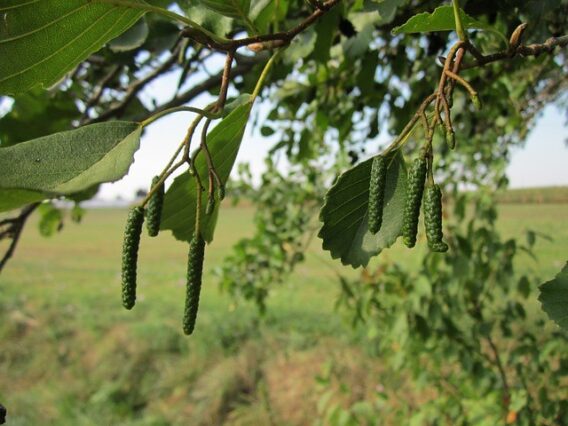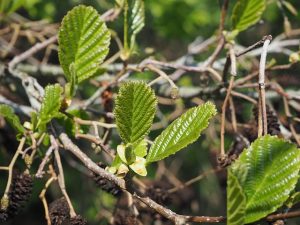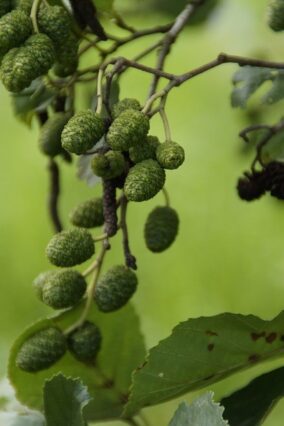An Alder tree (Alnus glutinosa) is a member of the Birch tree family. Alders are fascinating and versatile members of the tree family. They are known for their distinctive characteristics and ecological significance. So let’s take a look at what makes Alder trees special!

The Mighty Alder: Transforming Soil for New Growth
Alder trees, often referred to as “pioneer species,” play a crucial role in ecosystem development. They have the remarkable ability to condition the soil by fixing nitrogen, making it fertile and suitable for other tree species to grow. This process, known as nitrogen fixation, involves Alder trees forming a symbiotic relationship with nitrogen-fixing bacteria. These bacteria live in nodules on the tree’s roots and convert atmospheric nitrogen into a usable form for plants.
Due to their preference for wet habitats, Alder trees are commonly found along the banks of streams, ponds, or in boggy woodlands. They thrive in these moist environments where other tree species may struggle. Alder’s tolerance for waterlogged soils allows it to effectively colonise and stabilise these areas, acting as a natural flood defense by providing erosion control.
Through their presence, Alder trees contribute to the diversity and resilience of ecosystems. Their ability to condition the soil and create favorable growing conditions paves the way for the establishment of other tree species, fostering a richer, more complex habitat. Moreover, Alder trees provide valuable wildlife habitat, offering shelter and food sources for various animal species.
Identifying the Alder Tree

This deciduous tree grows quickly to a height of approximately 25 feet, and is fairly short lived at 150 years.
Leaves – the leaves of the Alder tree open in April, and grow on long stems. They grow to approximately 10cm. They are light green and rounded, although they do taper to a slight point near to the leaf stalk. The leaf edges are wavy, and have distinct veins, and fall off the tree in late autumn.

Bark – the older bark on an Alder tree is a grey colour and has fissures, while the young bark has a greenish or light brown hues and spots. The new stems are sticky.
Flowers – once the male and female catkins of Alder trees emerge, they create a stunning display of contrasting colors. The elongated, yellow male catkins sway in the breeze, releasing pollen that gets carried by the wind. Meanwhile, the female catkins are green and have an oval shape. These catkins contain tiny flowers with receptive stigmas, waiting to be pollinated.
When fertilisation occurs, the female flowers undergo a transformation, developing into green, cone-like fruits known as strobiles. These strobiles, resembling small pine cones, are composed of scales that protect the developing seeds. As the strobiles mature, they turn brown and release their seeds to the wind, aiding in the dispersal of Alder tree offspring.
The flowering period of Alder trees, with its vibrant male and female catkins, not only adds visual interest to the landscape but also contributes to the reproductive cycle of these remarkable trees. It is a testament to the intricate mechanisms of nature and the beauty found in every stage of a plant’s life.
Uses for Alder
Fire – Seasoned Alder wood burns fairly quickly and produces a good amount of heat and coals. For a longer lasting fire, mix it with other types of wood. Avoid putting Alder on the fire if it is not properly seasoned as it will give off a lot of smoke.
Food – Charcoal made from Alder is good quality can be used to give a mild, smoky flavour to barbeque food. The chippings can be used to smoke food to preserve or flavour it, and works well with most meats and also salmon, giving it a sweet, smoky flavour.
Coppicing – Alder coppices well, and almost anything can be made from the wood, but the real benefit of the timber is that it has the advantage of withstanding continual wet and dry conditions. When used underwater, it hardens and withstands decay. In the past Alder wood was often used to make water troughs, water mill wheels, and lock gates. It has also been used in the construction of bridges. Read more about coppicing here.
Crafts – Because of the moisture content, carving green Alder wood is a pleasure. The soft wood is easy to shape and yields well under a tool, so many items can be carved. Traditionally, wooden clogs were often made from Alder wood.
The leaves and bark can be used in dye making. The freshly cut wood is white, but gradually turns to a red colour. A green dye can be produced from the flowers.
Health – Alder tree bark contains salicin, which converts into salicylic acid, an anti-inflammatory, in the body.
- A tincture made from the bark can be applied to the skin to soothe irritation from insect bites. Infusing the leaves, flowers and bark with a carrier oil, such as almond, creates a soothing balm that may help with some skin disorders, as will a poultice made from the leaves.
- Placing the leaves inside shoes is said to soothe aching feet and prevent swelling.
- Ingesting fresh Alder tree bark in any form will cause vomiting, so to use it for any reason other than externally, the bark needs to be dried first.
- A mouthwash made from Alder bark has been used to treat sore throats, inflamed gums, tooth ache and mouth ulcers.
Wildlife – Alder provides many benefits to wildlife. The pollen from the catkin is an early source of pollen for bees, and if the branches are above a stream or river, the seeds are a food source for fish. Alder is a good species for reforestation, and provide excellent shelter for wildlife in wet areas.
The roots of Alder trees add nitrogen to the soil, and improves its condition and makes it more fertile. Plant Alder to establish tree growth in water-logged or boggy areas, or to help prevent soil erosion.
